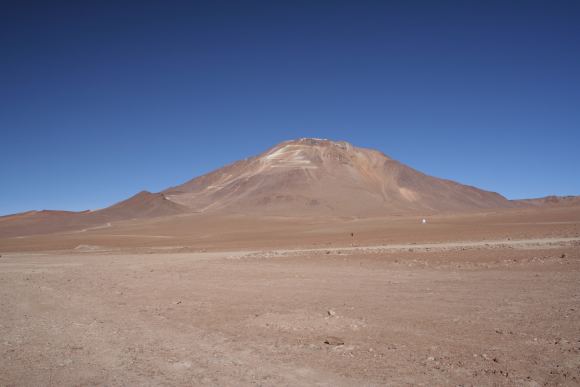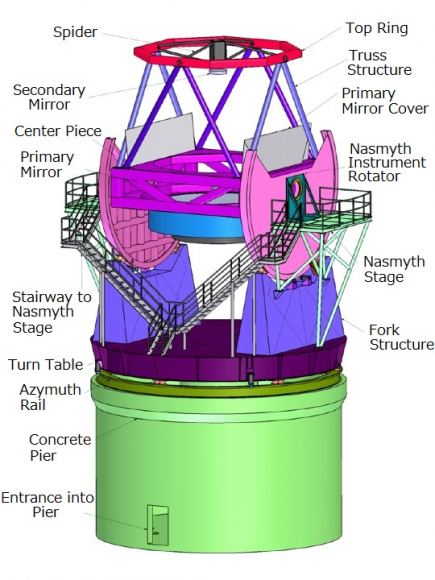The history of astronomy and observatories is full of stories about astronomers going higher and higher to get better views of the Universe. On Earth, the best locations are at places such as the Atacama Desert in Chile. So, that's where the University of Tokyo Atacama Observatory just opened its high-altitude eye on the sky, atop Cerro Chajnantor.
This unique new observatory, which was just commissioned on April 30th, sits at 5,640 meters (3.5 miles) above sea level, making it the highest observatory in the world—with a Guinness World Record recognition to prove it. The idea is to use this position in one of the driest areas of the world to get a closer look at planet-forming regions, evolving galaxies, and the earliest accessible epochs of cosmic history.
"Thanks to the height and arid environment, TAO will be the only ground-based telescope in the world capable of clearly viewing mid-infrared wavelengths. This area of the spectrum is extremely good for studying the environments around stars, including planet-forming regions," said Professor Takashi Miyata, director of the Atacama Observatory of the Institute of Astronomy and manager of the observatory's construction.
Building an observatory at such a high altitude may give astronomers a great view, but it's also is a difficult place to work. For that reason, the University cooperated closely with locals to build the observatory safely. It will be operated remotely as much as possible, to avoid risking human life in what can be very adverse conditions.
Why a Mid-infrared Observatory?
Objects and events in the Universe give off light across the electromagnetic spectrum. On Earth, we can detect much of that light, but not all of it. For example, Earth's atmosphere absorbs many infrared wavelengths. So, the higher a telescope is placed, the more infrared it can "see". Going to space (as astronomers have done with JWST, for example) is great, and a lot gets accomplished there. But astronomers can do quite a lot of very good astronomy at high altitudes, where conditions are dry and the atmosphere is thinner.
Mid-infrared is a particularly interesting "regime" of the electromagnetic spectrum. This is where we can start to "see" objects such as asteroids and planets. They re-radiate heat from their stars in the mid-infrared range. The same thing happens with dust around stars. It gets warmed and re-radiates in the mid-infrared. Disks of material around newborn stars—called protoplanetary disks—give off infrared radiation. Since these disks are where new planets form, infrared views give more detail about their evolution.
Mid-infrared studies of distant galaxies offer insight into their formation histories, as well as their star-formation rates. In addition, that range of wavelengths opens up a window into the activities and existence of active galactic nuclei. And, there's a lot more that mid-infrared observations of the Universe can tell astronomers.
TAO Specs
According to Professor Yuzuru Yoshii, the TAO project lead and principal investigator, the new observatory should provide unique insights at each wavelength it studies. "I'm seeking to elucidate mysteries of the Universe, such as dark energy and primordial first stars," said Yoshii. "For this, you need to view the sky in a way that only TAO makes possible."
The heart of TAO is a 6.5-meter mirror that will feed incoming light into specialized instruments. The Simultaneous-color Wide-field Infrared Multi-object Spectrograph (SWIMS) can observe a large area of the sky and simultaneously observe two wavelengths of light. The other is the Mid-Infrared Multi-field Imager for gaZing at the UnKnown Universe (MIMIZUKU). It peers into the dustier regions of the Universe. Both will allow astronomers to efficiently collect information on a diverse range of galaxies and other structures in the Universe.
"Analysis of the SWIMS observation data will provide insight into the formation of these including the evolution of the supermassive black holes at their centers," said Assistant Professor Masahiro Konishi. "New telescopes and instruments naturally help advance astronomy. I hope the next generation of astronomers use TAO and other ground-based, and space-based, telescopes, to make unexpected discoveries that challenge our current understanding and explain the unexplained."
For More Information
The TAO Project
World’s Highest Observatory Explores the Universe
 Universe Today
Universe Today


